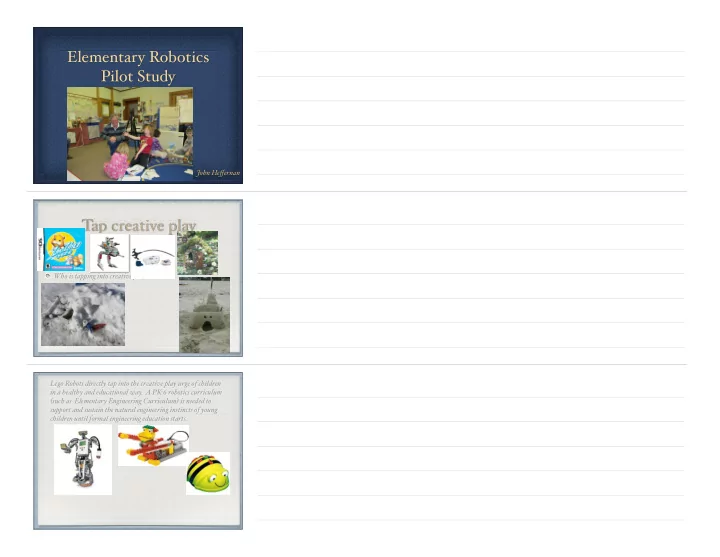

Elementary Robotics Pilot Study John He ff ernan Tap creative play Who is tapping into creative play? Are we? Lego Robots directly tap into the creative play urge of children in a healthy and educational way. A PK - 6 robotics curriculum ( such as Elementary Engineering Curriculum ) is needed to support and sustain the natural engineering instincts of young children until formal engineering education starts.
Broad Research Questions • How do grade K to 6 students’ robotics engineering ski lm s and processes change over time in terms of construction and programming as related to the engineering design process? • What impacts their ability to realize their design ideas at di ff erent ages? How are these related to developmental milestones? • What are the educational implications of these findings for curriculum, instruction, and assessment? • Can a model, fs amework, or learning progression be developed? Pilot Study Questions What are the best EDP models, theoretical fs ameworks, and methodologies to study the broad research questions? What does previous research have to say? For a grade 2 and grade 6 student, what are the di ff erences and similarities in their design processes, barriers, and strengths? How might these be related to development? Frameworks Constructivism ( Piaget, 1969 ) Map stages applicable to K - 6 ( preoperational, concrete operational, formal operational ) to grade levels List cognitive milestones Constructionism ( Papert, 1993 ) basis of curriculum Social constructivism ( Vygotsky, 1986 ) ,
Casual Reasoning Consists of quantitative ( math/data ) and qualitative mechanism ( science ) Need both ( Kuhn & Dean, 2004 ) Usua lm y a posteriori In general, engineers engage in a priori predictions ( mental projections ) about the performance of designs Relationship between theoretical fs ameworks, the 4 C’s and Robotics EDP Models Engineering/design models ( Portsmore, 2011; Crismond, 2012 ) Design process models are similar with di ff erent names and number of steps Design based science models include science processes
Portsmore ( 2011 ) Crismond & Adams ( 2012 ) Engineering design process model for this study
W elch ( 1999 ) Roden ( 1997, 1999 ) Previous Research - Gap Analysis No systematic longitudinal studies of children’s cognitive design processes Many ca lm s for more longitudinal studies - ( Crismond, 2012; Penner et al., 1997; Roth, 1996 )
Previous Research - Cognitive Summary Pilot Study Goals Establish task Establish methodology Establish data analysis Look for emergent themes Methodology Qualitative, Cross Case, Longitudinal, Cross - Sectional ( Yin, 2006 ) ( Borman, Clarke, Cotner, & Lee, 2006 ) Semi - clinical video interview ( Piaget & Inhelder, 1969 ) Microgenetic Analysis ( Chinn, 2006; Siegler & Crowley, 1991 ) Film one second grade student and one grade six student doing same open - ended engineering task ( Erickson, 2006 ) Transcribed and coded using grounded theory ( Glaser & Strauss, 2009 )
10" 15" 20" 25" 30" 35" 40" 0" 5" PLAN" RESEARCH" BUILD5NORMAL" BUILD5REBUILD" Count&of&EDP&Subcode&Phase&by&Grade&& PROGRAM5NORMAL" PROGRAM5REPROGRAM" EVALUATE5PHYSICAL" EVALUATE5VERBAL" EVALUATE5VISUAL" EVALUATE5SYSTEM" G6"Count" G2"Count"
10" 15" 20" 25" 30" 35" 40" 45" 50" AFFECT" 0" 5" ASYMMETRY" 0:00:00# 0:07:12# 0:14:24# 0:21:36# 0:28:48# 0:36:00# CONNECTION" CREATIVE5PLAY" PLAN# Unanticipated consequences Correct Projection Persist in non-optimal Code FINE5MOTOR" RESEARCH# IMPORTANT" Projection Data BUILD8NORMAL# MULTIPLE5PHASES" MATH" Time%in%EDP%Subcode%Phase%by%Grade%% PERSIST5BAD" BUILD8REBUILD# PROBLEM5SOLVING" Count&of&Non)EDP&Codes&by&Grade& PROJECT5CORRECT" PROGRAM8NORMAL# PROJECT5INCORRECT" PROGRAM8REPROGRAM# SCALE" SCIENCE" EVALUATE8PHYSICAL# SELF5TALK" SEMICONCRETE" EVALUATE8VERBAL# SEQUENCING" Grade 2 STABILITY" EVALUATE8VISUAL# STRATEGY" SYMMETRY" SYSTEMS5THINKING" TALK5ALOUD5ARTIFACT" EVALUATE8SYSTEM# 15 21 UNANTICIPATED5CONSEQUENCE" 8 TALK5TO5ROBOT" Grade 6 44 G6#Time# G2#Time## 0 0 "G6"COUNT" G2"COUNT"
Causal Reasoning Grade 2 student could not project out consequences of his design decisions ( also centration, trial and error ) Grade 2 student could troubleshoot and attempt to fix problems a fu er testing and teacher questioning ( concrete and semi - concrete evaluation ) Grade 2 student transitioning to concrete operation stage, lacks causal reasoning, formal operations would a lm ow mental projection of design choices beforehand Previous informal research showed fine motor at grade K and building at grade 1 to be primary cha lm enges Grade 2 Clip T ranscript Any ideas why it did not work? No Which block makes the car go? [ Points to last one. ] I think I am forgetting something. [ Traces wires and realizes problem. ] It’s supposed to go up here. [ Fixes motor not connected issue. ]
Grade 6 Clip T ranscript [ 00:20:29 ] [ PLAN ] BOY 11: I was thinking that I could have one that kind of connects on both sides but then a lm this would get in the way. So then I couldn’t rea lm y have it go around. [ PROJECT - CORRECT ] [ SYMMETRY ] Grade 6 Cycles
Mini EDP Cycle Grade 2 Process Grade 2 Persistence Grade 2 students persist in non - optimal design choices even when they manifest as very di ffi cult ( n=21 ) Likely reasons: causal reasoning, reversibility, centration See video
Design Concepts Design concepts and aesthetics - Sixth grader was concerned and could verbalize issues around symmetry, scale,and stability Grade 1, 2 tape example Programming W as not a major activity focus ( 8 % G6, 3 % G2 ) A lm mental projection 4 of 10 second graders did not choose to use computer
Educational Implications Functional Analysis ( Cross, 2008 ) - subsystems and top - down design Alternative ideas and starting over Teacher questioning to stimulate causal reasoning Stability, symmetry, balance, scale, and center of gravity LEGO specific building instruction Mapping to Cognitive Framework Study Limitations Sma lm sample size ( n=2 ) Di ff erence in levels Lack of gender diversity Lack of age diversity
Future Research More students, girls, levels Hone in on causality Define learning progression Resources johnhe ff ernan@verizon.net Kids Engineer - http://www.kidsengineer.com/ Elementary Engineering - Sustaining the Natural Engineering Instincts of Children
Recommend
More recommend